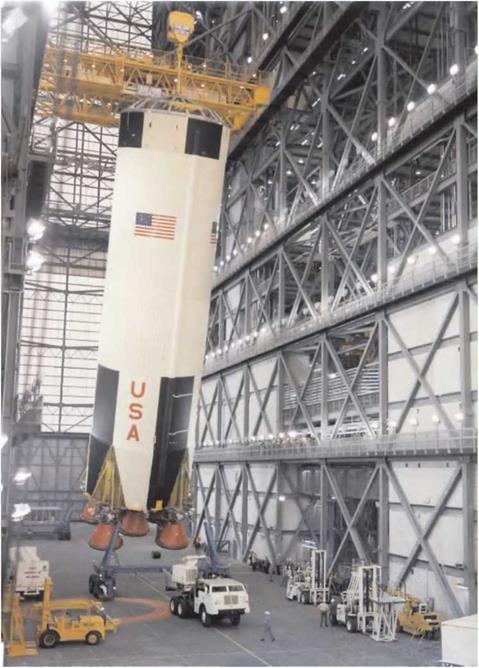The Saturn V
Engineers at Marshall worked through a series of potential configurations before they finally arrived at a super-booster that would have the capability to complete an Earth-orbital-rendezvous mission with two launches, or a lunar-orbital-rendezvous mission with only one – the Saturn V. Including the Apollo spacecraft and launch escape system on top, it was a 110-metre-tall behemoth. After an often acrimonious tendering process the manufacture of each of its three stages was assigned to a different company, and every part of the production was carefully monitored by NASA’s engineers. Each stage differed in size and power and each presented unique difficulties for its designers.
|
Apollo 8’s S-IC. stage during operations in the VAB at Kennedy Space Center, (NASA) |
The first stage: S-IC – Raw power
Although the S-IC (pronounced s-onc-e) was the largest of the Saturn V stages, its manufacturer, Boeing, had relatively few problems constructing it. The design was conservative and largely a straightforward stretch of then-current technologies. To lift the Saturn V’s 3,000 tonnes, five F-l engines were clustered at the base. Steering was provided by mounting the four outer engines on gimbals. The onboard guidance system pointed them very precisely to direct their great force in the direction required to send the space vehicle where it was intended to go. The rest of the stage’s 42-metre length comprised two huge tanks, each 10 metres across, stacked one above the other. Over 800.000 litres of refined kerosene fuel called RP-1, similar to that used in jet aircraft, sat in the lower tank, while the upper tank carried 1.3 million litres of very cold liquid oxygen (LOX) – a cryogenic propellant whose temperature had to be less than minus 183 C to render it liquid. Although the LOX tank was huge, reputedly not as much as the residue from a fingerprint was permitted to be left on its interior, lest this cause an explosion when LOX was pumped in. Live enormous insulated ducts from the LOX tank ran down through the fuel tank to feed oxidiser to the engines.
Despite its dominance of the Saturn V’s profile, the S-IC’s contribution to an Apollo flight lasted a little over 2 Vi minutes. Then it was cast away to fall into the Atlantic Ocean 650 kilometres from the launch pad. where 13 examples now litter the sea floor.











